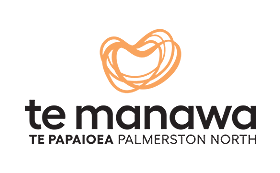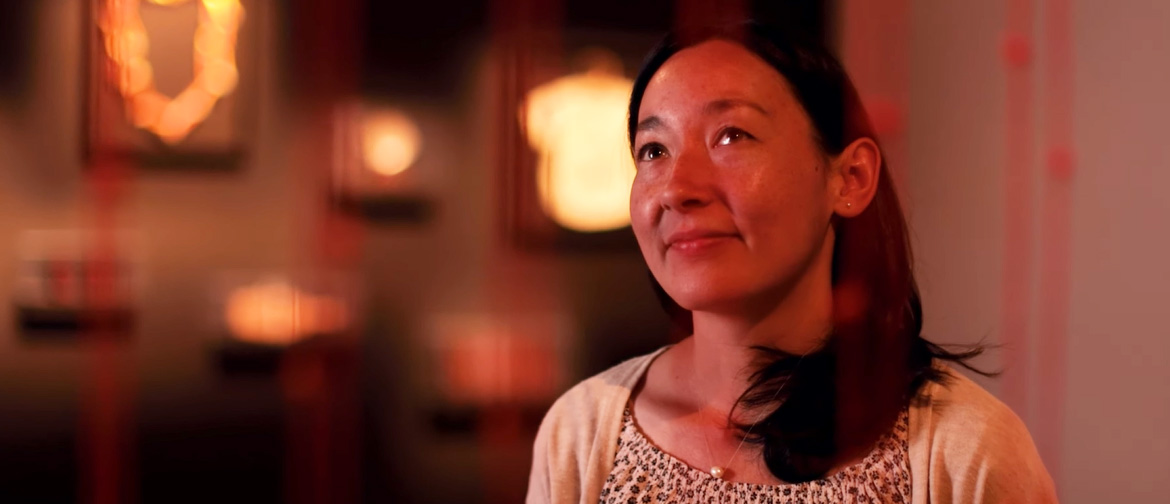There’s music in the gallery that houses Movements from Pearl Rivers, but beneath the soft beats and the Tongan bamboo flute there is another sound. A gentle whir at the edge of hearing. It’ll keep you guessing until you notice that one of the sculptures is alive. Tiny conch shells, paua shards and silk knots ascend endlessly on red thread, driven by a tiny motor and matched by movement in the opposite direction.
These elements represent the cultures of the South Pacific and southern China, two equal parts constantly travelling back and forth; an eternal exchange.
This theme is the great interest of artist Tessa Ma’auga, whose work has for years explored the connections between the people of these regions. Now four years into research for her PhD, Movements from Pearl Rivers is her third exhibition along these lines, and the second at Te Manawa.
“I’ve been looking at this connection between southern China and Aotearoa that flows from an ancient time when the ancestors of Austronesians or Polynesians left southern China,” Tessa says as she strolls amongst her sculptures, “and researching cosmological world-views indigenous to China and thinking about how that can inform the way we view our present situation.
“I use this Chinese cosmology to view the one-ness of humanity and the harmony amongst our diversity, and to talk about the relationships between Aotearoa and southern China – but which could apply to other countries and cross-cultural relationships as well.”
She also references the second diaspora of Chinese people that took place in the mid-19th century: when the colonial powers devastated the country in the Opium Wars, and many Chinese people fled or were taken abroad. Their descendants now live all over the world.
“I’m a 4th generation descendant of this dispersal. I have mixed heritage and many different cross-cultural ties,” Tessa says. “My great grandparents had migrated to North America. Dad grew up in an African-American neighbourhood; so our extended family is African-American and First Nations. Dad became a promoter of unity and diversity, of self-determination and equality, so that flows into this exhibition as well.”
The works in Movements from Pearl Rivers are an evolution of Tessa’s 2022 collaboration with Wai Ching Chan at The Physics Room in Ōtautahi Christchurch. That exhibition, Kāpuia ngā aho, recreated the four pillars of heaven from a Chinese origin story, using natural materials that brought shared Pacific and Chinese traditions into focus. Having always incorporated fibre in her work, Tessa began to learn about paper cutting, through which she could explore cross-cultural resonances while also communicating a narrative.
Down the walls of the gallery flow long scrolls of red rice paper, intricate imagery sliced precisely out of them, backlit to bring the story forward. Beginning with ancient cosmological origins and the evolution of the universe, the scrolls begin to depict species native to southern China, then the ocean voyages to Austronesia.
“The paper scrolls were a way to let everything I was researching just flow out, and to also meditate on the things that are close to my heart,” Tessa says. There’s a lot of motion, movement, journey and migration.”
Incredibly, Tessa prepared no designs for how she would cut into the scrolls, and made no preliminary marks on the paper itself. She simply picked up her knife and did the whole thing freehand: more than 10 metres of detailed imagery carved out of a kind of paper that’s known for being fragile.
“It actually flowed really nicely and naturally,” she says with a small reflective smile, as though it were just something one might do every day.
A tear or two is inevitable though, but Tessa just took mistakes or frustrations in stride
“I found it fit with the Chinese philosophy of art: it’s not just about creating a completed work, but it’s a spiritual process of cultivating the artist, the qualities of the artist as well as the qualities of the material you’re working with,” she explains, seeing lessons in the complications about the nature of our relationships, wherever they may form. “We can’t force things together hastily but must take a lot of care and make sure there’s integrity.”
With this exhibition, Tessa has introduced a new dimension by including items generously lent by members of the community, whose ancestors were part of the 19th century diaspora.
“These are from people that I’ve met naturally, living in Palmerston North, taking the kids to the park or the pool, and we realise that we have a connection to southern China,” she recalls.
The diversity of this display illuminates further the themes of the exhibition. Though many of the items appear to be Chinese, they’re from families whose heritage stretches across the Pacific. Māori, Samoan, Fijian, Cook Islands communities and more are all represented, each with their own way of expressing their shared Chinese ancestry.
The motors hum and the threads continue their perpetual cascade, pearls and tiny jade fragments glinting in the gallery lights. It’s these sculptures, with their threads of blended bamboo and banana, silk and cotton, that express the ideas at the heart of Movements from Pearl Rivers, uniting the cosmic and interpersonal.
“They offer this view of the oneness of humanity, this everflowing spirit that is permeating all of us and all of existence, and patterns in the universe, of ascent and descent which propel humanity forward,” Tessa says, “but also the migration of people, cultural exchange, and the importance of harmonious relationships.”
Movements from Pearl Rivers is open in the Art Gallery until 7 May. Entry is free.




